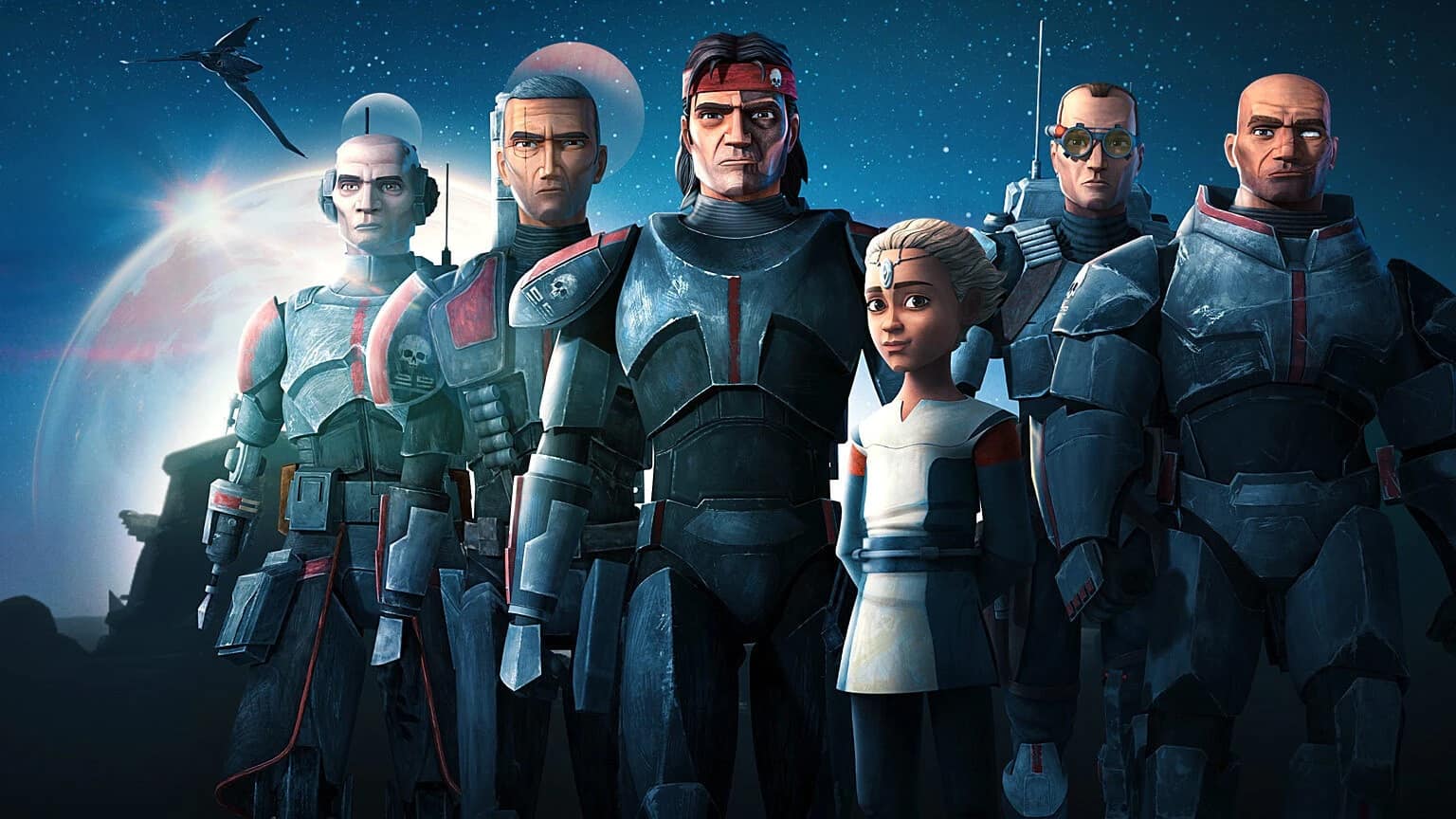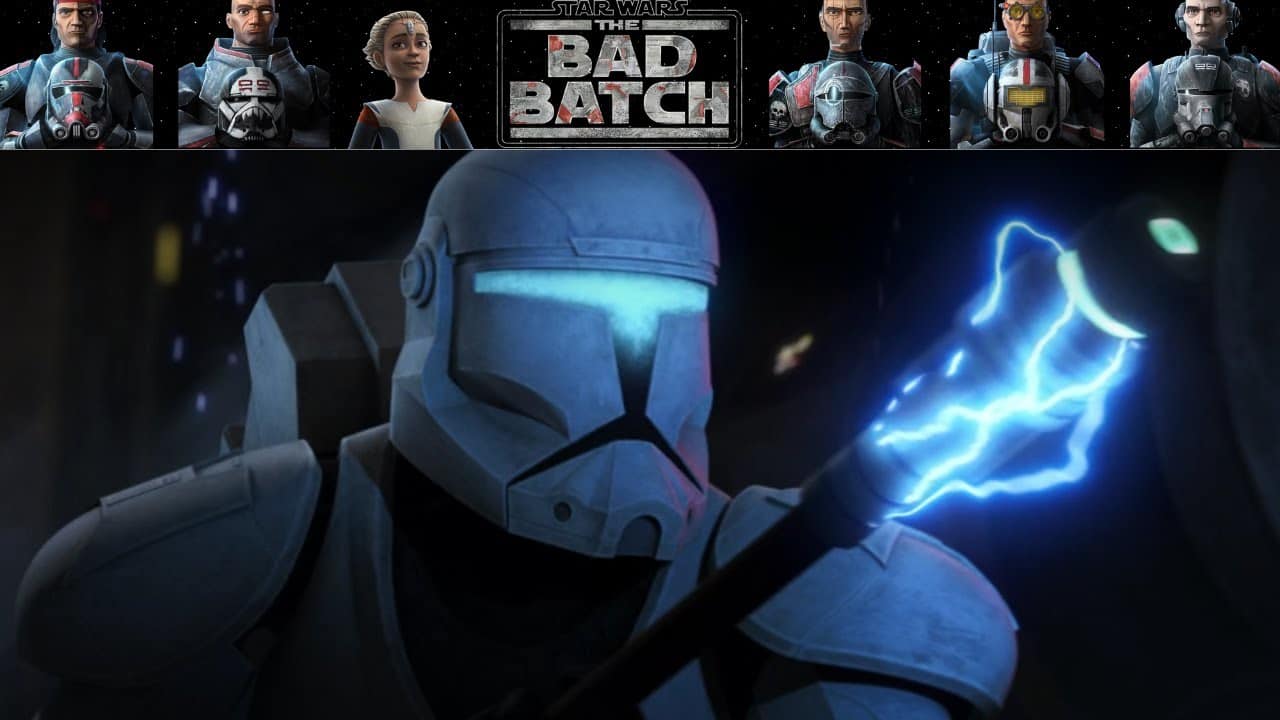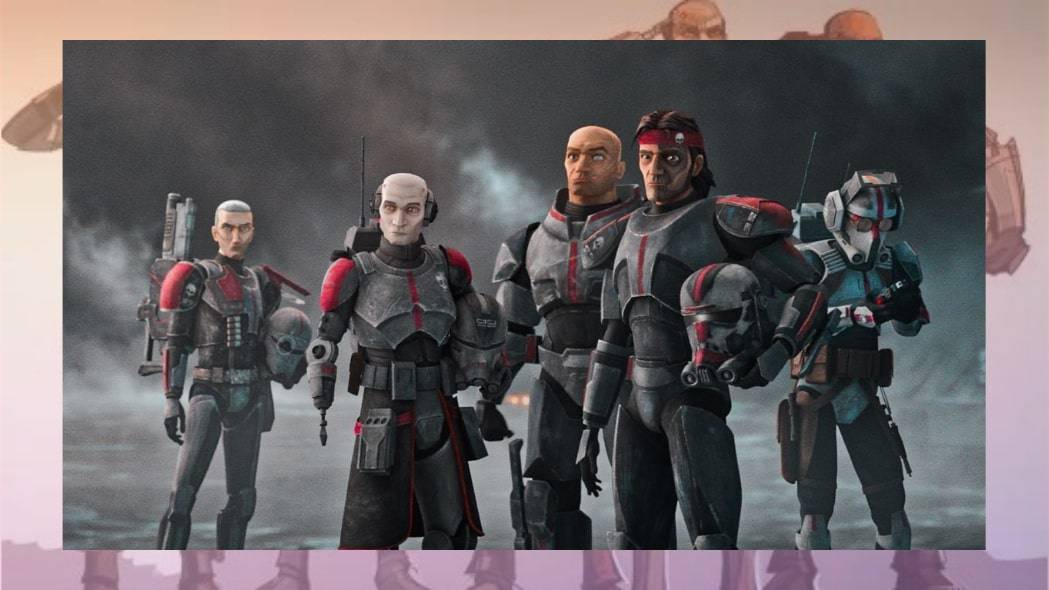The Bad Batch, an animated series created by Dave Filoni, is exclusively available on Disney+ in America. This show is an addition to the Star Wars franchise and serves as both a sequel and spin-off to the previous series, Star Wars: The Clone Wars. The talented team at Lucasfilm Animation produces The Bad Batch, with Jennifer Corbett as the head writer and Brad Rau as the supervising director.
In Star Wars: The Bad Batch, Dee Bradley Baker voices the Bad Batch members, a group of genetically mutated clone troopers who are an elite squad. Additionally, he reprises his role from The Clone Wars by voicing other clones in the series.
Omega, a female clone who becomes part of the squad, is played by Michelle Ang. The series was given the green light in July 2020 by Disney+ as a spin-off from The Clone Wars. The show was created by Filoni, Corbett, and Rau.
On May 4, 2021, the first season of Star Wars: The Bad Batch, which comprised 16 episodes, premiered and ran until August 13. The season received acclaim from critics. The second season, which also contains 16 episodes, started airing on January 4, 2023, and will conclude on March 29.

Star Wars: The Bad Batch Plot
The Bad Batch, alternatively called Clone Force 99, comprised exceptional clone soldiers possessing genetic mutations and made their debut in Star Wars: The Clone Wars. This squad takes on daring mercenary missions following the conclusion of the Clone Wars.
What makes the Bad Batch unique among their fellow clones is their ability to resist the effects of Order 66. While the rest of the clone army was transformed into brutal and obedient servants of Emperor Palpatine, the members of the Bad Batch managed to maintain their independence and free will.
Due to their unique abilities, they become outlaws in the early days of the Galactic Empire. At the same time, Grand Moff Tarkin begins to gradually replace the use of clones with human recruits as part of the Empire’s military forces.
Despite this, the Bad Batch continues to defy the Empire and fight for what they believe in. Their loyalty to each other and their cause makes them an inspiration to others who are fighting against the oppression of the Empire.

Summary of Star Wars: The Bad Batch Season 2 Episode 11
Star Wars: The Bad Batch Season 2 Episode 11, “Metamorphosis,” was released on March 1, 2023. The episode was written by Sabir Pirzada. Saul Ruiz produced the episode.
Doctor Royce Hemlock journeys to an Imperial facility on Mount Tantiss, where he meets Nala Se, a Kaminoan geneticist. Hemlock attempts to convince Se to participate in the Emperor’s cloning projects, but she refuses to comply.
Meanwhile, a covert transport heading towards Mt. Tantiss gets stranded, and Cid assigns the Bad Batch to recover the lost cargo. During their search, they come across an immature Zillo Beast, which was cloned in secret and intended to serve as a living armament resource.
As the Bad Batch explores the wreckage, they are ambushed by an Imperial strike force that was sent to retrieve the Beast and capture anyone who may have seen it.
The Bad Batch retreats, but shortly thereafter, Lama Su is brought to Mt. Tantiss to persuade Nala Se to cooperate. In exchange for his freedom, Su informs Dr. Hemlock about Omega’s existence, which raises the stakes even higher.
The Bad Batch is now on the run from the Empire, with a powerful and potentially dangerous creature in their possession. As they search their way through the treacherous landscape of the galaxy, they must keep the Beast safe while also trying to uncover the secrets of Omega’s past.
Along the way, they encounter new allies and enemies, each with their own motivations and agendas. The fate of the galaxy depends on the shoulders of this unlikely group of renegades, who will stop at nothing to protect what they hold dear.

Review of Star Wars: The Bad Batch Season 2 Episode 11, “Metamorphosis”
Jennifer Corbett and Dave Filoni’s Star Wars: The Bad Batch has captivated audiences with its thrilling adventures and engaging characters. The latest episode, “Metamorphosis,” is the eleventh of sixteen total episodes in the show’s second season, and it is an excellent example of how the series is continually evolving and growing.
The episode’s title is incredibly fitting, as we see the characters undergo significant changes and developments. We witness Omega taking on a more active role within the Bad Batch, proving herself to be a valuable member of the team. Meanwhile, Hunter is struggling to come to terms with his feelings of inadequacy as a leader, while Wrecker’s headaches continue to worsen, causing concern for his wellbeing.
But the changes in the characters are not the only evolutions taking place in the series. “Metamorphosis” also sees various threads from across The Bad Batch and the larger Star Wars galaxy coming together in one captivating and suspenseful episode. From the appearance of familiar characters to the exploration of new planets and cultures, the episode is a testament to the rich and varied world-building of the Star Wars universe.
As the season nears its conclusion, the stakes are higher than ever, and the tension is palpable. “Metamorphosis” sets the stage for a thrilling and action-packed finale, leaving viewers eager to see what happens next. With its dynamic storytelling and excellent character development, Star Wars: The Bad Batch continues to be a standout entry in the beloved franchise.
Despite its seemingly straightforward premise, “Metamorphosis” goes beyond being just another “creature-of-the-week” episode of Star Wars: The Bad Batch. At its core, the episode is a masterful demonstration of how a seemingly isolated story can have significant implications for the larger narrative.
The Bad Batch’s mission to retrieve the cargo of a stranded transport leads them to a strange creature, but the discovery of its origins and purpose have far-reaching consequences that shake the foundation of the show’s overarching story.
The episode cleverly weaves together various elements from past and present storylines, making “Metamorphosis” an essential chapter in the second season’s narrative. The creature, which is revealed to be a secretly cloned immature Zillo Beast, is a nod to the iconic creature that first appeared in Star Wars: The Clone Wars.
Additionally, the appearance of Dr. Royce Hemlock and his attempts to persuade Nala Se to participate in the Emperor’s cloning projects remind us of the Empire’s ongoing interest in creating an army of Force-sensitive clones. The revelation that Omega’s existence has been divulged to Dr. Hemlock raises the stakes and puts the entire squad in danger.
“Metamorphosis” is a thrilling and impactful episode that shows how the smallest details can have a significant impact on a larger story. The episode’s intricate interweaving of various story threads from both The Bad Batch and the wider Star Wars universe makes it a must-watch for fans of the franchise.
Jennifer Corbett, Dave Filoni, and the team behind The Bad Batch have been incorporating various cinematic influences into the show’s second season, including nods to iconic films such as Indiana Jones and the Last Crusade and Godzilla.
In “Metamorphosis,” the primary influence is Ridley Scott’s classic sci-fi horror film Alien, which has become an integral part of pop culture. While many shows and movies have paid tribute to Alien by imitating its iconic narrative beats, “Metamorphosis” goes beyond that, tapping into the essence of what made Alien so impactful.
The episode’s narrative structure may seem simple at first, with the Bad Batch sent on a mission to investigate a downed ship and encountering a hostile creature on board. However, the devil is truly in the details, as the creature’s specifications and the ship’s design are intricately woven into larger story threads, culminating in a shocking revelation that ties back to the overarching plot of the series.
By drawing from Alien’s power and horror, “Metamorphosis” creates a sense of unease and tension that permeates throughout the entire episode. From the claustrophobic and dimly lit corridors of the abandoned ship to the creature’s gruesome transformation, the episode taps into the same sense of dread that made Alien such a groundbreaking film.
“Metamorphosis” stands out as a prime example of how The Bad Batch is evolving and expanding its storytelling, drawing inspiration from classic films while still maintaining its own unique identity within the Star Wars universe.
Right from the first few frames of the episode, every aspect of the production works in perfect harmony to capture the unique aesthetic and visual language of Ridley Scott’s iconic film, Alien. Director Saul Ruiz and his team have gone to great lengths to emulate the cinematic splendor and power of the 1979 classic, using everything from the lighting and set design to the sound effects to create an immersive and thrilling experience for the audience.

Despite the episode eventually veering away from its direct Alien influences, Ruiz’s direction remains rooted in the same principles that made Scott’s work so effective. As a result, the episode maintains a high level of clarity, suspense, and impact, keeping viewers on the edge of their seats throughout.
Whether it’s the use of shadow and light to create an atmosphere of fear and uncertainty or the expertly choreographed action sequences, every moment of the episode is crafted with precision and attention to detail.
The episode is a testament to the power of strong direction and the importance of creating a cohesive visual style. By tapping into the essence of a classic film like Alien, Ruiz and his team have created a work that is both reverential to its source material and a thrilling standalone experience in its own right.
Sabir Pirzada’s script for the episode is not just limited to the text from Ridley Scott’s Alien, as the writer delves deep into the subtext of the classic horror film. The script manages to capture the essence of the film’s underlying themes and messages, exploring them in a way that adds a fresh and intriguing dimension to the story.
In the episode, the horror elements are framed through the lens of an Imperial experiment gone wrong, which draws clear parallels between the actions of the company, known as Weyland-Yutani in later films, and the experiments conducted by the Empire. The script explores the consequences of unchecked corporate greed and the exploitation of technology and resources, themes that are at the core of the Alien franchise.
By examining these themes and weaving them into the story, Pirzada’s script adds layers of complexity and nuance to the episode. It creates a sense of urgency and tension as the characters are forced to confront the consequences of the company’s actions and the danger that it poses to everyone around them.
The script for the episode is a masterful exploration of the subtext of Ridley Scott’s Alien, providing a fresh perspective on the underlying themes and messages of the franchise. Pirzada’s work adds depth and dimension to the story, elevating it beyond a simple retelling of the original film and making it a compelling standalone experience in its own right.
The episode “Metamorphosis” is not only fascinating in a meta-textual sense but also in the way that Sabir Pirzada’s writing uses this concept as a foundation for introducing the series’ new villain, Dr. Royce Hemlock. The character, played by Jimmi Simpson with a simmering rage that is palpable, is a fantastic addition to the series, and his impact is immediately felt from the moment he is introduced.
Pirzada’s writing builds Hemlock’s introduction in a way that establishes him as a bona fide threat, one that the Batch has not faced before. The character’s restrained but simmering anger and cunning intellect are on full display, making it clear that he is not to be underestimated. Hemlock’s presence injects a sense of danger and unpredictability into the series, raising the stakes and keeping the audience on the edge of their seats.
Moreover, Hemlock’s character adds an intriguing layer of complexity to the series, as his motivations and allegiances are not immediately clear. The enigmatic nature of the character, combined with his undeniable threat level, creates a sense of unease that permeates throughout the episode.
Overall, Pirzada’s writing succeeds in introducing a fascinating new villain to the series, one that adds depth, complexity, and danger to the Batch’s already perilous mission. Hemlock’s impact is felt immediately, and his character promises to be a driving force in the series’ ongoing narrative.
Our Verdict
“Metamorphosis” stands out as another outstanding episode of The Bad Batch. Dee Bradley Baker and Michelle Ang’s performances as the lead characters remain authentic and emotionally charged, bringing a surprising depth to their roles. The animation, framing, and lighting in this episode are breathtaking, especially given the immense scale of the production.
The episode’s creative team has clearly put a tremendous amount of effort into developing and challenging the characters of Clone Force 99, and it shows in the final product. “Metamorphosis” sees the walls closing in around the protagonists as they face new challenges and unexpected twists in their journey.
Through it all, the creative team has managed to maintain the authenticity and emotional resonance that has made The Bad Batch such a captivating series. The attention to detail in the animation and visual design is truly impressive, bringing the Star Wars universe to life in a way that feels both fresh and familiar. The sheer scale of the episode, from the expansive landscapes to the intense action sequences, is a testament to the creative team’s dedication and skill.
Overall, “Metamorphosis” is a special episode of The Bad Batch, showcasing the incredible talent of the show’s creative team. Through its captivating plot, impactful acting, and breathtaking visuals, the episode establishes the series as a formidable contender in the Star Wars realm. As the series continues to develop and evolve, fans can look forward to more exciting adventures and unexpected twists from Clone Force 99.
Our Rating: ⭐ (4/5).





